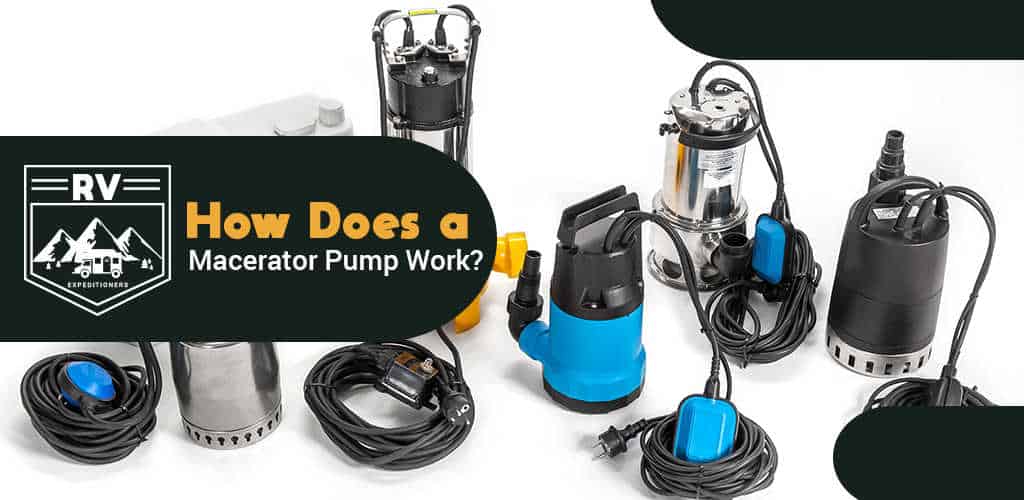A macerator pump can help you minimize the mess when dumping waste from your RV. It reduces the waste to a slurry by grinding and mashing the larger particles.
This can come in handy when pumping waste up an incline. Basically, if you have a macerator pump you have more options when it comes to accessing dumping locations.
But how does a macerator pump work and should you really get one? Depending on which type of macerator pump your RV has, the process, as well as the pros and cons, differ slightly.
There are two types of macerator pumps that go on RVs: permanent built-in macerators and separate units. It’s also worth pointing out that not all macerators are electric-powered. Some are hydraulic for if you have a reliable backflow assembly to pair them with.
How It Works
A macerator pump essentially functions as a garbage disposal system for your black water tank. It grinds up the waste to create a thinner and more fluid waste product. This allows you to use smaller hoses and makes it easier to pump the waste over greater distances and incline.
Here’s how you can use an external macerator pump when you want to dump the waste from your RV:
- Connect the pump to the sewer drainage point
- Attach an exit hose to the pump
- Put the other end of the hose into free disposal point
- Plug the pump in an open outlet or connect it directly to your battery if you can
- Open the drain valve
- Start the pump
- Wait for the waste flow to stop before shutting off the pump
- Backflush for a couple of seconds (30 or 40 seconds)
- Turn the pump back on
- Repeat the previous two steps until you see only clean water coming through
Four Very Important Tips
If you run the pump dry, you risk burning it out, unlike many electric pumps for liquid. This is a common problem even with some high-end macerators. Always turn the pump off after the flow stops.
Invest in clear elbows to connect the sewer hose to the RV waste valve fitting. These aren’t always necessary but they’re great as a precaution. Clear elbows will allow you to see if and how well the macerator pump works. It should let you spot signs of backflushing or clogging.
If you’d rather not stay and watch the process unfolding, at least try to stay within earshot of the macerator pump. If you hear a high-pitched whine it means that the macerator is running dry so you may have to deal with a blockage.
Macerators use a lot of power so you risk blowing fuses. Be very careful when adding up the power provided by your RV battery or power bank before buying a macerator pump
What Are The Benefits Of A Macerator?
The macerator reduces the need to use landfills by slicing up and disposing of recycled papers directly into the waste system. Reduced water and electricity consumption are also among the ways to reduce environmental impact due to short cycle times.
Advantages and Disadvantages
The question of how a macerator pump works has been answered, but that doesn’t mean you know everything you need to know before investing in one for your RV or buying an RV with a built-in macerator pump.
You also need to know about the pros and cons of using one. It may seem highly useful to liquefy the waste before dumping it but that’s not always the case.
Pros
- You can pump liquefied waste up inclines
- You can pump the waste over larger distances, making parking less of an issue
- It makes it easier to reach in-ground sewage pipes and drains
- You can even dump your waste in toilets or city sewage lines (where it is allowed)
Cons
- Compared to dumping waste through a standard 3” sewer hose, the process can be a lot slower
- Macerator pumps are an additional (optional) investment
- Regardless of the type, you will have to use more water to dump the black water tank contents
- You need to stay close and monitor the situation
- Excessive pressure can occur which may blow up fittings
- One more component to maintain in your RV
- Not servicing the impellers regularly can cause the macerator pump to slow down, thus increasing the time it takes to dump waste
- Liquefying waste into a slurry will make it sticky. This too can cause the pump to work slowly and increase the waste disposal time
Closing Thoughts
At the end of the day, using a macerator pump is a matter of personal preference. Not everyone wants to bother taking on another gadget that needs constant maintenance. Some people may not appreciate the risks involved with using a macerator pump.
Alternatively, you can go with a macerator pump that’s built into your toilet so that you turn everything into a slurry as you go.
If you're looking to buy one, these are the ones we like.
An exterior macerator pump may cost up to $400. It’s not cheap but at least you don’t have to worry about installation costs and making room for it near your toilet. A built-in macerator pump usually requires a professional installation.


How much money do I need to spend on a macerator pump? Can you recommend to me? Thanks
I got a macerator pump and it was spent about $400. I think this is a fair price for the results I got from it. Thanks for sharing!
My macerator pump was not working but after reading this post, now I can repair it. Thanks